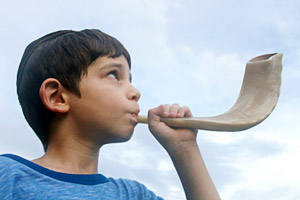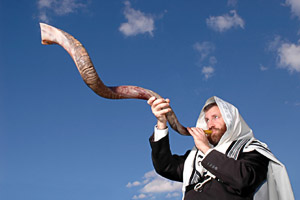   | ||
 | ||
 | ||
 |
 |
Introduction | Purchase | Shofar Basics | Shofar History
Shofar Basics
“With trumpets and shofar sound, call out before the King, YHWH.”
Psalm 98:6

Did You Know?
Jews from Central and Eastern Europe use shofars which have a very high, thin and weeping-like sound. There rams horn shofars are also bent. The Jewish people in these communities believe this symbolises the human heart, which should be bent before the Lord.

Did You Know?
For many years, Jews were not permitted to play the shofar at the Western Wall in Jerusalem. However, after the Six Day War, when Jerusalem was finally united and under Israeli control, Rabbi Shlomo Goren was permitted to approach to the Wall and play the Jewish shofar there once more.
Caring for your Shofar
With proper care and attention, your shofar will last a lifetime (and potentially several!). To keep it clean, simply dust and polish your instrument with a dry, soft cloth. Do not use water. Your shofar horn is made of keratin (like your hair and nails) so store out of direct sunlight and at room temperature. All of our shofars have been specially treated to minimise odour.
Playing your Shofar
A shofar is played in a similar fashion to a horn, using the vibrations of the lips. Each shofar has a unique sound, depending on its size, length and the diameter of the mouthpiece. Learning to play the shofar can be hard work. But it's easy once you know how!
- First, tighten your lips to fit the hole of the shofar. You should only be able to blow and suck in air from a small central hole in your lips, not from the sides.
- Next, blow out air as hard as you can, making your lips vibrate. At this point you will begin to sound like a trumpet yourself! Moistening your lips may help.
- Now you've practiced blowing, put the shofar to your mouth on the point where your lips vibrate most, usually in the centre. Give a sharp, hard blast of air through your mouth until you hear shofar sounds. The secret to blowing the shofar is not a lot of air, but vibrations. You can make higher sounds by tightening your lips, causing faster vibrations.
Traditional Shofar Sounds
The Jewish people developed a traditional pattern of sounds for the shofar. However, these patterns are not the only way to sound the shofar. Experiment with different sounds and patterns as you are led in your worship.
Tekiah is the first sound, one long blast on a single note.
The second, Shevarim, is made up of three short blasts, starting low and moving to the next note up.
The third sound is called the Teruah, nine very fast, high blasts played in succession.
The Tekiah-Gedolah is usually the final pattern. It is a very long blast, with the player holding the sound for as long as he or she can.
The following YouTube videos provide excellent demonstrations of these Shofar patterns.
Using a Ram's Horn Shofar
We offer a range of shofar instruments and tools including Ram's Horn Shofars, Yemenite Kudu Shofars, Oryx Shofars and Rams Anointing Horns.
Introduction | Purchase | Shofar Basics | Shofar History

All Designs | Concepts of God | Attributes of God | Declarations | Leadership | The Fruit of the Spirit | The Nations | National Flags
Home | Silk Design Gallery | Wielding Banners | Common Questions Answered | About purchasing online
Our Mission | Workshop Calendar | Workshop Info | Links | Newsletters | Contact Us
Out Of Our Minds Banners: enquiry@worshipbanners.orgPhone: +61 417 636 747PO Box 98, Harlaxton 4350, AUSTRALIA
©2002-2024 Out Of Our Minds Banners Site maintained by IDO